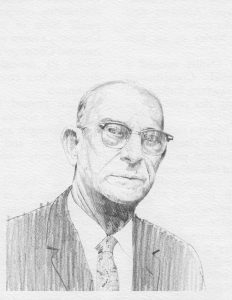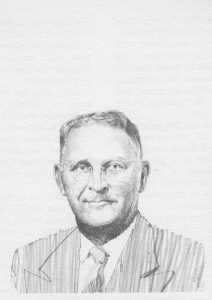Edward Asbury O’Neal IV was born in Florence, Alabama, on September 9, 1905. In the years that followed, his rise from chemical industrialist to international businessman to Chairman of Monsanto, one of the largest corporations in the U.S., took him far from his native soil. But his roots remained in Alabama where his values had been shaped by a family whose history and tradition in the state dates from the days of Andrew Jackson.
Son of Edward Asbury III and Julia Hartwell (Camper) O’Neal, the young man, with his brother and sister, grew up in Florence and on the nearby family farm. He attended Florence Normal School and Coffee High School, from which he graduated in 1922. Because young Ed’s family wanted him to become a minister, he entered Davidson College in North Carolina. He soon transferred to science, and after four successful years during which he displayed qualities of wisdom, initiative, and friendliness, he graduated in 1926 with a B.A. degree in physics.
The young graduate had decided he wanted to return to the family farm and raise cotton, but the problem was that cotton was selling for seven cents a pound. His father (who had returned to the family farm after being educated as a lawyer, and had become the organizer and a long-term president of the American Farm Bureau Federation), told him that “someone has to pay the taxes.” An admirer of the growing chemical industry, his father sent his son to Theodore Swann, who gave young Ed a job as a laboratory assistant for $75 a week with the Swann Company in Anniston, manufacturer of phosphate.
Years later, Ed O’Neal said, “About six months later, someone down there noticed the lab job didn’t seem to be my turn of hand, so I was given a few odd jobs in the plant … ”
That was the beginning. 1928, he was superintendent; by 1936, assistant parts manager; and by 1938, plant manager.
While settling in Anniston, Ed had met Mildred Pruet, a native of Ashland, Alabama. They were married in 1928. They subsequently had three daughters-Mildred (Mrs. David V. Palmer, of London, England); Julia Ann (Mrs. Prescott W. Gould of Santa Barbara, California); Nancy O’Neal of New York City; and a son, Edward Asbury O’Neal V of New York City.
Monsanto had acquired the Swann Company a few years after Ed O’Neal began work. In 1941, he was sent to Trenton, Michigan, to manage a new Monsanto phosphate plant being built there. In a life increasingly dominated by the war effort, Ed O’Neal took over the construction and start-up of the new phosphate plant in Trenton. In spite of a cold winter and war-time shortages, by the end of 1942, he had the plant running at total capacity (about three times the output of the Anniston plant) and all products sold out.
In May 1944, Ed O’Neal was promoted to Production Manager of the entire Phosphate Division of Monsanto, a position that led him to move his family to St. Louis, Missouri. When World War II ended, Edgar M. Queeny, then head of Monsanto, sent Ed O’Neal on a “scouting trip” to England, to determine whether it would be practical to continue the company’s British subsidiary in view of the possibility that the new Labor government might nationalize the industry.
When he returned after two months of consultation with leading officials in business and government circles to recommend that the company keep and expand its British branch, Chairman Queeny said, “Fine. You go over there and do it.”
Thus, in January 1946, the O’Neal family, which was becoming increasingly mobile and adaptable, sailed on the Queen Mary for their new home in England, where Ed O’Neal served as Managing Director of Monsanto Chemicals Limited from 1946-53.
After thoroughly learning about British banking and finance, government policy, and trade, Ed O’Neal established and implemented an ambitious plan of expansion and research financed mostly by British capital which he engendered. Under his leadership,-. Monsanto Chemicals Limited in England increased sales from $9 million in sales to
$75 million in less than 10 years and became the headquarters of a vast overseas operation ranging from Continental Europe to Australia and New Zealand. His success with the British company soon led to his involvement with Monsanto’s other overseas operations. He became chairman of Monsanto Canada, Ltd. and a director of Monsanto of Australia.
By 1953, Ed O’Neal had been promoted to head of Monsanto’s Overseas Division, a position which required that he return to Monsanto’s headquarters in St. Louis, Missouri. As an established international business figure, he became a strong member of the company’s top management team. He was elected a vice president in 1954 and a member of the Board of Directors in 1955.
In the early 1950s, Chemstrand Corporation, a joint venture of Monsanto and the American Viscose Corporation in the production and sales of synthetic textiles, was showing poor profit performance and market growth. The equal ownership and equal board participation had held back the company’s ability to respond to change and to new ideas-management needed reorganizing and the company needed a specific strategic plan and the backing to implement it. Because Ed O’Neal had the first-rate experience in all these areas and the style and drive to get the job done, in 1956 he was asked to become president of Chemstrand. He resigned from his Monsanto positions and moved his family to Decatur, Alabama, where Chemstrand’s main plant was located.
Ed O’Neal took over the helm at Chemstrand and turned a “loser” into a winner. With a new organization and management team, new spirit, and sound planning, Chemstrand expanded into new and growing markets. New plants were built in North Ireland, in Israel, in Luxembourg, and in South Carolina; a major research center was established in North Carolina’s Research Triangle Park.
By 1959, Chemstrand’s earnings had become greater than the Net Income of Viscose Corporation and only $8 million less than Monsanto’s earnings. The growth had been a result of good products and good marketing. He was re-elected vice president in 1962.
In 1965, Edward Asbury O’Neal IV was named Chairman of the Board of Monsanto and a member of the finance committee. During his three years of tenure, this proven leader, international planner, and implementor helped both consolidate and direct the activities of the now gigantic and prosperous organization. He retired as Chairman in 1968 and ended all executive duties in 1969, though he remained on the Board until 1975.
Edward Asbury O’Neal IV died in St. Louis on December 6, 1977. He was buried in his hometown, Florence, Alabama. As the Florence Times stated, “… the name O’Neal means much, not only to Florence, where the roots are planted but to the whole United States as well. The community is saddened by the passing of another in the line of extraordinary O’Neals.”





